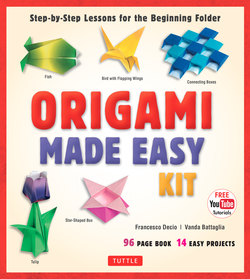Читать книгу Origami Made Easy Ebook - Vanda Battaglia - Страница 8
ОглавлениеChapter 1
THE VALLEY FOLD
TOPICS AND SYMBOLS
| Valley fold indicated by a row of dashes | |
| Arrow indicating the direction of a valley fold | |
| Fold and unfold arrow | |
| Crease created by a fold | |
| Paper edges | |
| Line widths | |
| Numbered steps | 1 - 5 - 8 - 17 - 21 |
PRACTICE MODEL
| Place Card Holder |
The Valley Fold Line
The valley fold, indicated by a row of dashes, is one of the two basic folds used in origami. In a valley fold, one part of the sheet always remains firmly on the table, while the other is moved into a new position above the part on the solid surface.
To make a valley fold on a sheet of paper, one side of the sheet is lifted from the surface, and then folded into a new specific position. No matter how much a sheet is flattened after a fold is made in this way (fig. 1), the crease will create a little channel, which, if enlarged (fig. 2), resembles a valley.
The Arrow Indicating the Direction of a Valley Fold
An arrow with one tip is used to indicate which edge should be lifted and/or in what direction it should be moved. It can also indicate the exact point to which a given edge should be taken. Here are three examples of arrows associated with the valley fold.
Examples of the use of the valley fold symbol with different arrows.
The bottom edge must be drawn to the top one.
The right edge must be positioned over the left one.
The left corner must be drawn to the opposite (right) one.
The Fold and Unfold Arrow
In origami, every fold serves as the basis for the next one. Sometimes folds need to be unfolded. The fold and unfold maneuver is indicated by an arrow with a curved shaft and two tips, one at each end. Here are some examples.
Several applications of the symbol are illustrated below. The operation required is always the same—fold and unfold.
The Crease Created by a Fold
Once made, a fold is indelible. It is impossible to conceal. But the problem can be minimized, especially if the fold serves as the basis for the next one. A crease created by a fold is represented by a fine line. Here are images of the sheets illustrated on page 8 after the fold-and-unfold maneuver has been completed.
The Widths of Lines and Borders
The lines used to indicate folds are fairly thick (about 0.5 mm). In contrast, the line indicating a crease made by a fold is thin (about 0.15 mm). The border or outline of every figure is about 0.35 mm thick, which is about halfway between the other two widths. Only these three widths are used in origami.
Numbered Steps
A sequence of numbers indicates the order of the steps needed to fold a model. A “trick” that can be used when encountering a problem with a step is to look ahead at the next step, since each diagram shows the result of the preceding step. By looking at the result of the previous fold, you should get a clearer picture of the step you are currently having trouble with.
Happy folding with your first model!
Recommended paper size: 6 x 6 inches (15 x 15 cm)
Crease pattern showing the finished model’s folds
The initial sheet of paper and the final model juxtaposed
Practice Model:
Place Card Holder
Make a valley fold along the horizontal median, and then unfold.
The fold made in step 1 is represented by the thin horizontal line. Make a valley fold along the vertical median, and then unfold.
Valley fold the right and left edges to the central crease, and then unfold each.
Valley fold the top and bottom edges to the central crease, and then unfold each.
Make valley folds at each of the four corners.
Make valley folds on the right and left sides by bringing their edges to the crease along the center.
Your paper will look like this once step 6 has been completed. Flip the model over.
Flip over the model. The side that was facing the working surface is now on top, and vice versa. Make a valley fold along the existing crease line, and then unfold.
The fold required has already been creased. Make a valley fold, and then unfold.
Make a valley fold, aligning the bottom edge with the crease along the center.
Tuck the top edge into the “pocket” indicated by the arrows. This will make the model three-dimensional.
The finished Place Card Holder. A tag with the name of the guest can now be inserted into it, or the name can be written directly on the white central portion.
